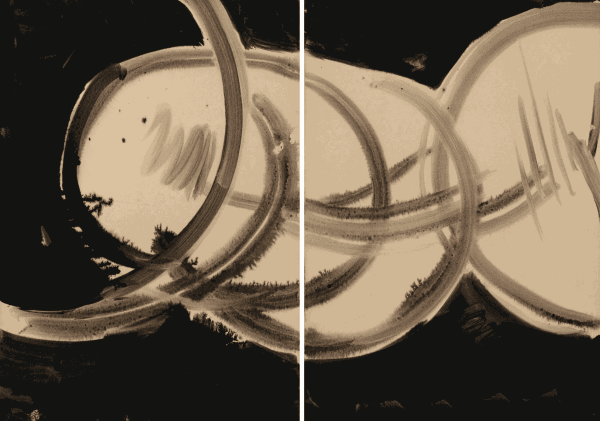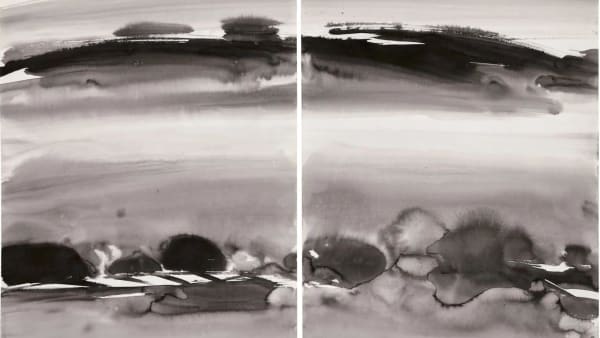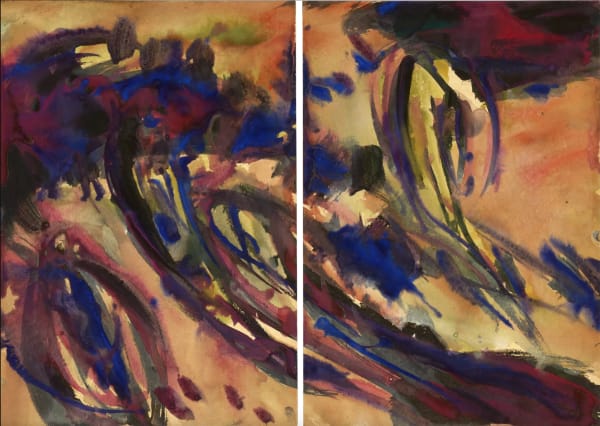T'ang Haywen: Chemins de l'encre: Printemps Asiatique 2024
“I am searching for an art of no constraints in which I can develop freely.”
“I am searching to liberate myself from the conscious world, to surpass it in order to explore new forms, while always in touch with nature and its rhythms. I am looking to identify myself with the forces of nature and to materialize them through painting.”
One of the great masters of ink of the second half of the 20th century, the work of T’ang Haywen (1927-1991) reveals a profound universe, full of sensibility and of intensity. His artistic production focused essentially on landscapes and is marked by the use of ink. Fascinated by his grandfather’s work as a calligrapher and by the oeuvre of Shitao, the great calligrapher, poet and landscape artist of the 17th century Ming dynasty, who marks the break with the traditional Chinese style, T’ang decided to consecrate his life to painting. T’ang Haywen mastered the fundamental, millennium old art of his country – ink – and he followed the equally millennium old philosophical precepts of Taoism, which gave to China its political and cultural basis: a life of harmony with nature and the universe around us.
One of the three great Chinese painters in Paris in the aftermath of World War II, T’ang belongs to the wave of exiled artists that found in Paris the favourable conditions in order to exercize their art, in what is simply known as the School of Paris. When he arrived in Paris, the post-war world was simmering: “new realities”, intuition and spontaneity were the mots du jour. The very principles of mechanization and reason were questioned. In this climate of the triumph of lyrical abstraction and abstract expressionism, both of which find a source in Oriental calligraphy without copying it, an artist such as T’ang can thrive. He is freed to go between form and meaning, between calligraphy and painting. Having only the basics of traditional calligraphy taught by his grandfather, T’ang joined the Académie de la Grande Chaumière in Montparnasse, one of the most renowned art schools in Paris. There he also learned the Western way of painting. T’ang’s art lies at the confluence of these two great influences, between China and France. Considered as one of the great artists of this period, T’ang has all the characteristics of a capital figure in the movement. However, in contrast with Zao Wou-Ki and Chu The-Chun, he never joins a group, valuing his liberty as a mark of honour.
-
 T'ang HaywenSans titre, 1974Ink on Kyro paper70 x 100 cm (diptych)Signed in red ink on the lower right corner
T'ang HaywenSans titre, 1974Ink on Kyro paper70 x 100 cm (diptych)Signed in red ink on the lower right corner -
 T'ang HaywenSans titre, 1975Ink on Kyro paper70 x 100 cm (diptych)Signed in red ink on the lower right side.
T'ang HaywenSans titre, 1975Ink on Kyro paper70 x 100 cm (diptych)Signed in red ink on the lower right side. -
 T'ang HaywenSans titre, 1967Gouache and ink on Kyro board.70 x 50 cm.
T'ang HaywenSans titre, 1967Gouache and ink on Kyro board.70 x 50 cm. -
 T'ang HaywenSans titre, 1975Ink on Kyro board70 x 100 cm
T'ang HaywenSans titre, 1975Ink on Kyro board70 x 100 cm
27 1/2 x 39 3/8 in.
Diptych -
 T'ang HaywenSans titre, 1972-3Ink on Kyro board70 x 100 cm
T'ang HaywenSans titre, 1972-3Ink on Kyro board70 x 100 cm
27 1/2 x 39 3/8 in.
Diptych -
 T'ang HaywenSans titre, 1970Ink on Kyro board70 x 100 cm
T'ang HaywenSans titre, 1970Ink on Kyro board70 x 100 cm
27 1/2 x 39 3/8 in.
Diptych -
 T'ang HaywenPortrait, 1985-1990Ink, watercolour and gouache on Arches paper.18 x 18 cm.Signed on the lower right-hand corner.
T'ang HaywenPortrait, 1985-1990Ink, watercolour and gouache on Arches paper.18 x 18 cm.Signed on the lower right-hand corner. -
 T'ang HaywenPortrait, 1985-1990Ink, watercolour and gouache on Arches paper.18 x 18 cm.Signed on the lower right hand corner.
T'ang HaywenPortrait, 1985-1990Ink, watercolour and gouache on Arches paper.18 x 18 cm.Signed on the lower right hand corner. -
 T'ang HaywenPortrait, 1985-1990Ink, watercolour and gouache on Arches paper.18 x 18 cm.Signed on the lower right-hand corner.
T'ang HaywenPortrait, 1985-1990Ink, watercolour and gouache on Arches paper.18 x 18 cm.Signed on the lower right-hand corner. -
 T'ang HaywenPortrait, 1985-1990Ink, watercolour and gouache on Arches paper.18 x 18 cmSigned on the lower left corner.
T'ang HaywenPortrait, 1985-1990Ink, watercolour and gouache on Arches paper.18 x 18 cmSigned on the lower left corner. -
 T'ang HaywenSans titre (Portrait), 1985Watercolour on Arches paper11 x 15 cm
T'ang HaywenSans titre (Portrait), 1985Watercolour on Arches paper11 x 15 cm -
 T'ang HaywenSans titre (Portrait), 1985Watercolour on Arches paper11 x 15 cm
T'ang HaywenSans titre (Portrait), 1985Watercolour on Arches paper11 x 15 cm -
 T'ang HaywenSans titre (Portrait), 1985Watercolour on Arches paper11 x 15 cm
T'ang HaywenSans titre (Portrait), 1985Watercolour on Arches paper11 x 15 cm -
 T'ang HaywenSans titre, 1985Ink on Arches paper10.5 x 11 cmSigned on the lower right corner.
T'ang HaywenSans titre, 1985Ink on Arches paper10.5 x 11 cmSigned on the lower right corner. -
 T'ang Haywen, Sans titre, 1975
T'ang Haywen, Sans titre, 1975 -
 T'ang HaywenSans titre, 1970Ink, wash and gouache on Kyro cardboard70 x 100 cm
T'ang HaywenSans titre, 1970Ink, wash and gouache on Kyro cardboard70 x 100 cm
Diptych -
 T'ang HaywenSans titre , 1985Ink on Arches paper.14 x 13.5 cm
T'ang HaywenSans titre , 1985Ink on Arches paper.14 x 13.5 cm
Double-faceSigned on the lower right. -
 T'ang HaywenSans titre (Portrait), 1985Ink on Arches paper13.5 x 12 cmSigned on the lower right.
T'ang HaywenSans titre (Portrait), 1985Ink on Arches paper13.5 x 12 cmSigned on the lower right. -
 T'ang HaywenSans titre , 1980Watercolour on paper10 x 10.5 cmSigned on the lower right.
T'ang HaywenSans titre , 1980Watercolour on paper10 x 10.5 cmSigned on the lower right. -
 T'ang Haywen, Sans titre, 1972
T'ang Haywen, Sans titre, 1972 -
 T'ang HaywenSans titre, 1983-84Gouache on paper30 x 42 cm
T'ang HaywenSans titre, 1983-84Gouache on paper30 x 42 cm
DiptychSigned on the lower right corner. -
 T'ang HaywenSans titre, 1983-84Gouache and ink on paper
T'ang HaywenSans titre, 1983-84Gouache and ink on paper
30 x 42 cm
DiptychSigned on the lower right corner. -
 T'ang Haywen, Sans titre, 1983-84
T'ang Haywen, Sans titre, 1983-84 -
 T'ang HaywenSans titre, 1985Watercolour on paper22.3 x 38 cm
T'ang HaywenSans titre, 1985Watercolour on paper22.3 x 38 cm
Diptych

























